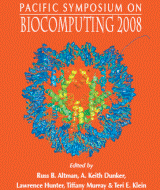Filling the Gaps Between Tools and Users: A Tool Comparator, Using Protein-Protein Interactions as an Example
Yoshinobu Kano1, Ngan Nguyen1, Rune Sætre1, Kazuhiro Yoshida1, Yusuke Miyao1, Yoshimasa Tsuruoka3, Yuichiro Matsubayashi1, Sophia Ananiadou2,3, Jun’ichi Tsujii1,2,3
1Department of Computer Science, University of Tokyo Hongo 7-3-1, Bunkyo-ku, Tokyo 113-0033 Tokyo;
2School of Computer Science, University of Manchester PO Box 88, Sackville St, MANCHESTER M60 1QD, UK
3NaCTeM (National Centre for Text Mining), Manchester Interdisciplinary Biocentre, University of Manchester,
131 Princess St, MANCHESTER M1 7DN, UK
Pac Symp Biocomput. 2008;:616-627.

Abstract
Recently, several text mining programs have reached a near-practical level of performance. Some systems are already being used by biologists and database curators. However, it has also been recognized that current Natural Language Processing (NLP) and Text Mining (TM) technology is not easy to deploy, since research groups tend to develop systems that cater specifically to their own requirements. One of the major reasons for the difficulty of deployment of NLP/TM technology is that re-usability and interoperability of software tools are typically not considered during development. While some effort has been invested in making interoperable NLP/TM toolkits, the developers of end-to-end systems still often struggle to reuse NLP/TM tools, and often opt to develop similar programs from scratch instead. This is particularly the case in BioNLP, since the requirements of biologists are so diverse that NLP tools have to be adapted and re-organized in a much more extensive manner than was originally expected. Although generic frameworks like UIMA (Unstructured Information Management Architecture) provide promising ways to solve this problem, the solution that they provide is only partial. In order for truly interoperable toolkits to become a reality, we also need sharable type systems and a developer-friendly environment for software integration that includes functionality for systematic comparisons of available tools, a simple I/O interface, and visualization tools. In this paper, we describe such an environment that was developed based on UIMA, and we show its feasibility through our experience in developing a protein-protein interaction (PPI) extraction system.
[Full-Text PDF] [PSB Home Page]